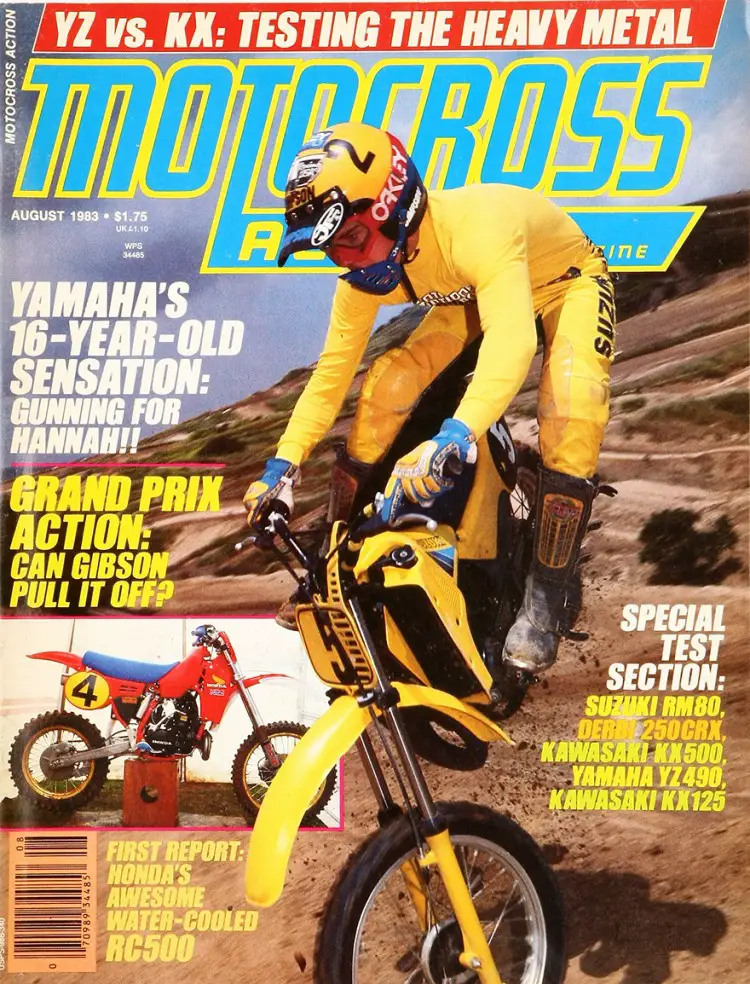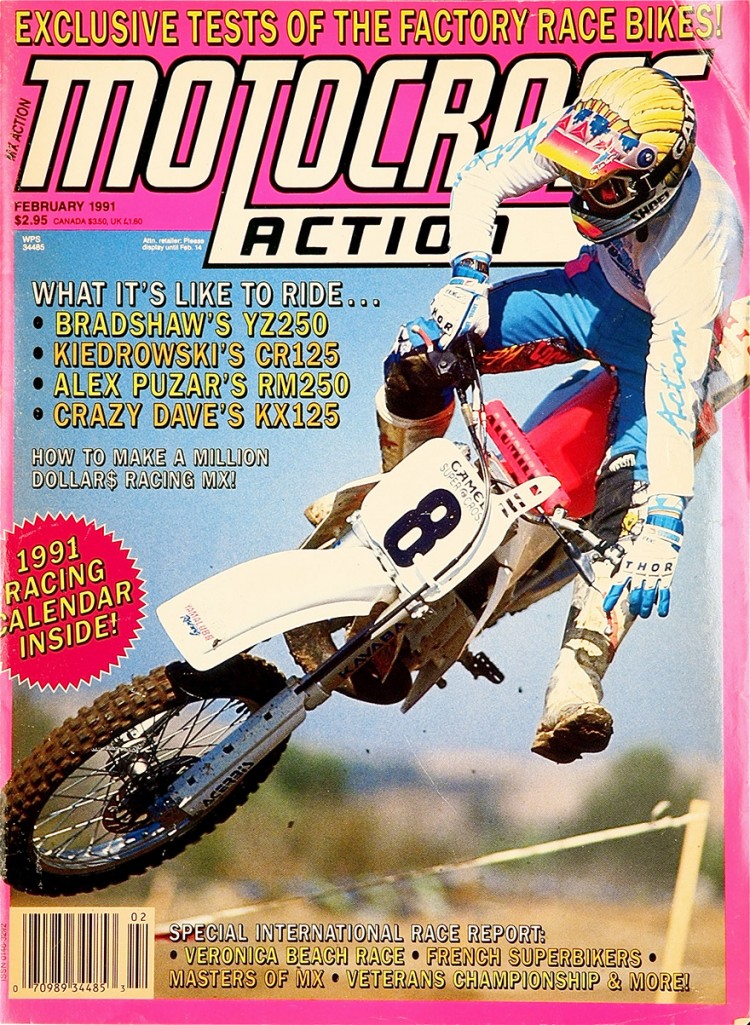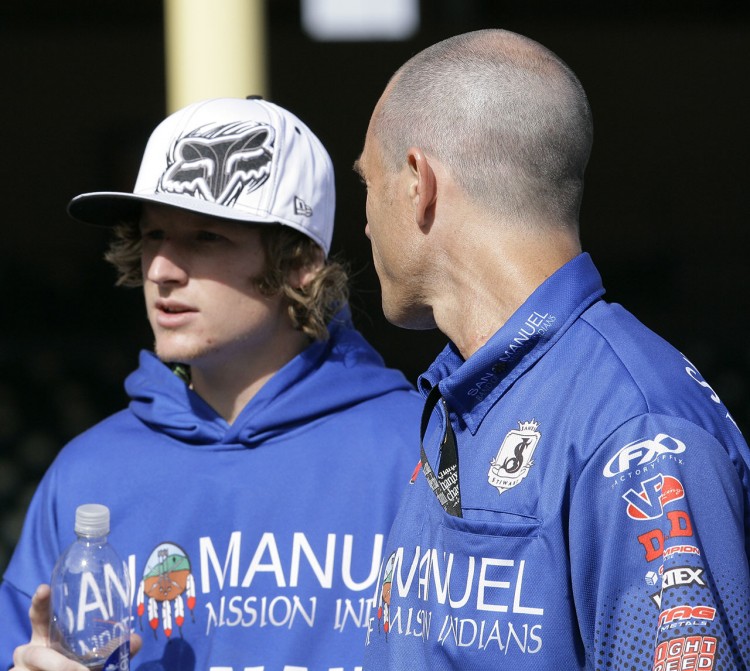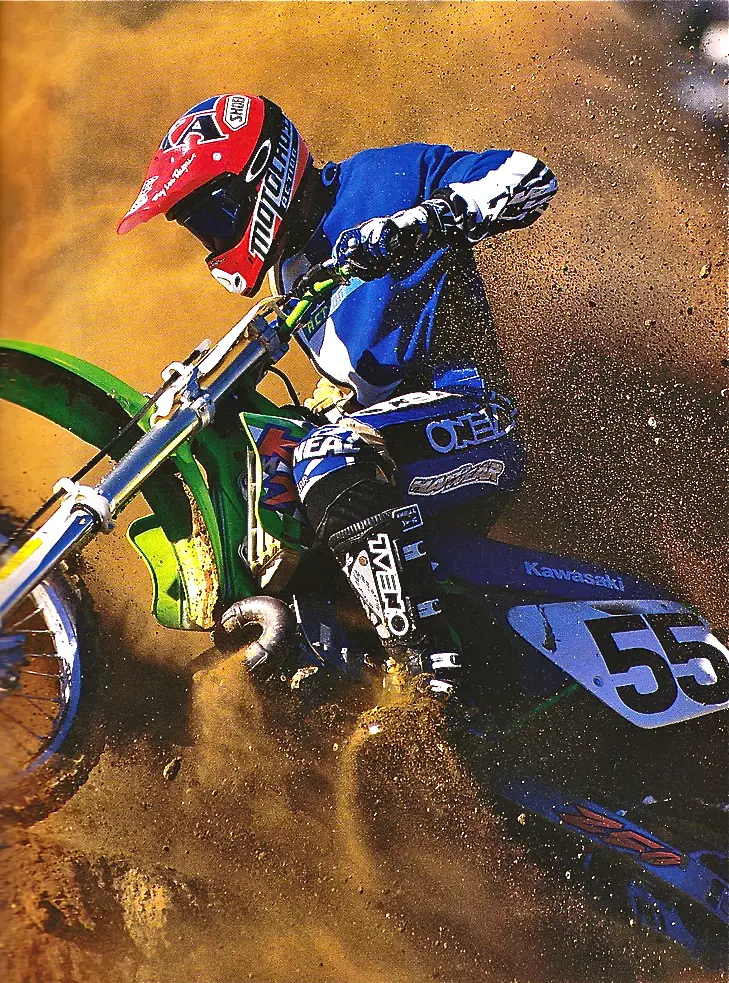MXA INTERVIEW OF THE WEEK: LARRY BROOKS
 Larry Brooks landed his first MXA cover in August 1983 while testing a Suzuki RM80.
Larry Brooks landed his first MXA cover in August 1983 while testing a Suzuki RM80.
By John Basher
Do you remember Larry Brooks, the mini cycle amateur sensation from Southern California? What about the Larry Brooks that won three races over a 12 year professional career? If not, then how about the Larry Brooks that won titles as team manager for riders like Jeremy McGrath, Grant Langston and James Stewart? Believe it or not, they’re all the same person. Suffice to say that Brooks has done a lot in this sport.
Larry holds a special place in MXA’s hearts, because he was a long-time MXA test rider who appeared on the most covers of all-time. More than that, he’s a great guy. I caught up with Larry to ask what life was like as an MXA test rider, as Jeremy McGrath’s team manager, and to find out which professional racer in his opinion is the best rider in the paddock. His answers are very revealing.
What was life like as an MXA test rider? It was pretty fun, actually. I got to ride all kinds of different bikes and try factory bikes. It was a blast. I got to hang out with the MXA guys during the week and every weekend at the races.
Do factory bikes really make that much of a difference? They do. Factory bikes are finely-tuned production bikes. The suspension is quite a bit better, while the engines are super fast compared to the production bikes.
What was your favorite bike that you ever tested? It would have to be Damon Bradshaw’s Yamaha YZ250 from 1991 or 1992. I can’t remember what year it was. That bike was unbelievable.
What about a favorite production bike? Back in the day the Honda was always a really good production bike. Then, as time went by, Yamaha stepped up quite a bit. I’ll go with the Honda, though.
Do you remember the first time you met Jody Weisel [Editor at MXA]? It was at Saddleback Saturday in 1983. I had just started riding at Saddleback, and somehow I just started talking to him. I didn’t even know who he was at first. Then I realized he was the MXA Editor. We just kind of hit it off. I did a Suzuki RM80 test for him one day. I think it was the first 80cc mini cycle featured on the cover of Motocross Action. From there we got to be really good friends.
 Larry on Damon Bradshaw’s works Yamaha YZ250 in 1991.
Larry on Damon Bradshaw’s works Yamaha YZ250 in 1991.
How long did you test bikes at MXA for? Gosh, it was from the RM80 test and I stopped doing it once I started managing race teams. The reason I could no longer do it is because I didn’t have any time.
What was your proudest moment as a racer? There were quite a few moments. I would say that winning the Under-21 World Championship was a big thing. It was held in Italy, and it was like the Motocross des Nations for riders under 21. I don’t remember who the Europeans were at that time, but the other Americans on the team were Billy Liles, Bobby Moore and Mike Fisher.
Was it difficult making the transition from racer to team manager? I never thought it was difficult, because I thought that racing and taking all of the risks as a racer was much harder. Being a team manager was simple for me. I got to coach the riders and do all of the things that I would do anyway as a racer. I walked the track and talked to the riders about line selection and things like that. The only difference is that I didn’t have to take the risk anymore. The great thing is that I still got to race, only in a different way. I got to race through the riders.
What was it like to work with Jeremy McGrath at Chaparral Yamaha? It was fun. He was an easy rider to work with. He was a nice guy and always calm. Jeremy was so much faster than the other guys that it seemed like he was just riding around the track. It honestly taught me a lot. Working with such a great rider made me learn so much more than I had as a racer. Working with Jeremy really helped, because I was able to benefit a lot of other riders I worked with after Jeremy.
After Chaparral Yamaha you transitioned to the team manager role at factory KTM. KTM at that time wasn’t quite like it is today. What was it like to work at KTM? We were just starting to dip into the 250 class, but KTM didn’t have as much experience building a 250. We were still racing two-strokes at that point. We won the 125 National Championship with Grant Langston in 2003. Ryan Hughes, also on KTM, finished second overall that year. After that is when the KTM four-stroke came out. We had a bunch of second places in the 250–or Lites, as they called it–back then. Mike Alessi got second. Josh Hansen tied for the Supercross East title, but Langston beat him out when he was at Pro Circuit. Mitch Payton at Pro Circuit Kawasaki was a thorn in my side at that point. He won all the championships, and we finished second in all of them.
 Larry (left) with Andrew Short and Jeremy McGrath during the press introduction of the Supercross.comHonda racing effort. The team would eventually fold, but not before Short won his one and only 450 Supercross main.
Larry (left) with Andrew Short and Jeremy McGrath during the press introduction of the Supercross.comHonda racing effort. The team would eventually fold, but not before Short won his one and only 450 Supercross main.
Did you ever imagine that KTM would be where they are today, given their place in the racing scene a decade ago? Like I told Stefan Pierer [KTM President/CEO] at the time, if they put linkage on their bike then they could have won championships. Having PDS suspension on the bike was the only thing holding us back. The shock was so one-dimensional that you couldn’t really set it up for the whoops and also the big jumps. You had to take a middle-of-the-road setup, and it was never that good in the rear end. As soon as they went to linkage I knew they were going to excel.
In talking about the 2003 AMA 125 National Championship between teammates Langston and Hughes, it seemed like there was quite a volatile relationship between those two. What happened behind closed doors? It was difficult at times, but I think it helped me. I worked with a bunch of different personalities while I was at KTM. Langston was a laid-back guy. Ryno was very explosive. Then we had Josh Hansen, and he was goofy. There was also Mike Alessi and Tony Alessi, which is a story in itself. Those varying personalities educated me on working with different riders. I dealt with each rider individually and tried to address their specific needs.
After KTM you moved to San Manuel Yamaha, and Chad Reed was the main rider. Then came James Stewart. Reed and Stewart will forever be linked together. What was it like working with Reed, and then Stewart? They were a lot alike. It’s funny to even think that way, but they both wanted to win really badly. Every champion has that in them. They were fragile in confidence at times, so we worked with them to bring that confidence back up. They were such great riders and talents that you had to get their mind right. Both could win on any given day.
 Larry worked with a bunch of great talents, including Josh Hill.
Larry worked with a bunch of great talents, including Josh Hill.
Of all the racers you’ve worked with, who has been the best test rider? Chad Reed. He could always set his bike up. We would jump around a little bit, but he always knew what he wanted. He could feel a lot through the bike, and he could give pretty good feedback. He was quirky at times, but he knew what he wanted. Chad’s bike setup was always really good. You could take his bike setup and give it to just about anyone in the pits, and they would think it’s the best motorcycle ever.
Would you say that most of the top Pro riders know bike setup? Are they familiar with how to properly set up their bikes, or do they rely on speed and talent? I find that the better the rider the less they know about bike setup. They know what they want, but they’re going after a feeling. They might not be able to tell you technically what they want, but they know the feel they want as far as the balance of the bike with the way the fork and shock work. Chad Reed was always searching for something in the chassis, which you’re limited to on the motorcycle. Chad had a great feel, and he could always give you really good feedback on what the bike was doing. Then the technical guys, whether they were suspension, chassis or motor guys, would work together to figure it out. That’s where I came in. I was the mediator between the rider and the technical staff. I could speak rider talk and relay it to the technical guys. That’s why I think I had some success as a manager.
There was a time back while working for James Stewart that you wrote a weekly website column on MXA. It was a popular feature, although you caught some flack for always standing up for your riders. Is it hard to stand up for your riders? No. I always felt like I was doing the right thing for my riders. As far as writing the article, I thought it was fun. I enjoyed speaking to the masses through an article. Unfortunately, some people took it the wrong way. The internet is such a powerful thing these days. It gives everyone a soap box to stand on and say what they want. For me, it was fun to tell people the way things were from the inside. I found that people were looking for controversy, and they would write things to try and beat me up for some reason. I do miss writing that article, though.
 Brooks throwing roost on the 1997 Kawasaki KX250.
Brooks throwing roost on the 1997 Kawasaki KX250.
You stepped away from the race scene for a bit. What were you doing in that time off? I was working for Chaparral Motorsports. I did different things, like selling bikes on the showroom floor. I realized that I didn’t like doing that very much. Then I went into working on side-by-sides. We modified them with aftermarket parts, and we built our own cages and things like that. Chaparral is huge in the side-by-side business. It was almost like racing in a way. We had some talented guys, and it was fun. The only thing is that I missed the excitement of racing on the weekends.
Now you’re back, and working for the Blue Buffalo Slater Skins team. How did the opportunity come about? John Slater of Slater Skins and I have been friends for a long time. We were talking one day, and he knew I wanted to get back into racing. Blue Buffalo was going to make a bigger push into racing. They had a small team in 2015. John needed somebody to manage riders and do the things that I do. It worked itself out.
You still take things very seriously. I remember seeing your face at Anaheim 1 after Michael Leib missed the show. It looked like you were going to punch out the first guy that said anything to you. [Laughter] I think any racer that starts managing a team will have the same intensity on the sidelines as they did when they were racing. If they don’t then they’re not doing their job correctly. You always want to win and do well. Your rider might not win, because there’s only one winner, but as long as your rider gives a lot of effort and the bike runs properly then it’s a good night. You look at the whole package. It’s never as simple as the gate dropping and your rider finishing. There are so many different things that come into play. So, yes, A1 wasn’t the greatest race for us. I took it to heart. Since then things have gotten a lot better for us.
What’s in your future? I thought about that when I was coming back. I didn’t want to jump straight back into a factory gig, because I didn’t want to be in a high-level stressful situation. I wanted to grow something again, kind of like I did with Chaparral in 1996. I started with a small team and grew it into something bigger. You have to be in it during the painful times and all the beginning stages to appreciate it. That’s what I’m doing right now. It’s fun, so far. It’s obviously not the San Manuel team, where we had an endless budget. At the same time, making it through the difficult stages is what makes a team.
If you were at the top of your game right now as a professional racer, how would you beat Ryan Dungey? Oh, wow. The fitness aspect of it has grown so much, even from when Jeremy McGrath was racing and winning. Ricky Carmichael took fitness to a new level. Now Aldon Baker has his program. You need to have all the pieces of the puzzle. Dungey has them. He’s consistent, fit, and he gets good starts now. It’s going to take a well-rounded rider to beat Ryan. He’s on his game. It’s not something that’s going to be easy for anybody. Once in a while someone will come out of the dark and beat him, but he’s always right there. You’re going to need to be fast and very consistent.
Thanks for your time, Larry. Thank you.





Comments are closed.